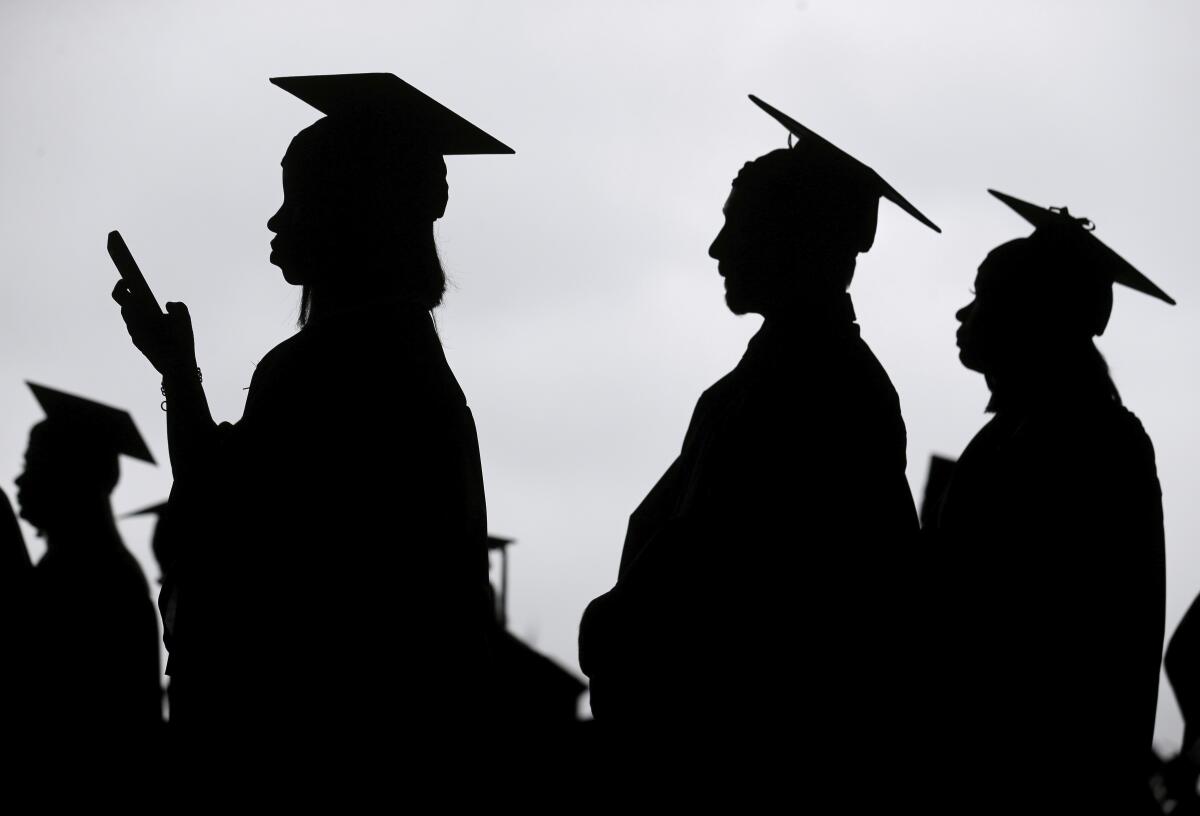Apodaca: We need to find solutions to the student debt crisis

- Share via
I was raised in a family that held sacred the value of education. My parents, the first in their families to earn college degrees, believed deeply in the intrinsic worthiness of higher education and saw college as the surest means of achieving personal and professional fulfillment.
So there was never any doubt that my three older siblings and I were expected to attend college. What we chose to do with that education was up to us, but we were going, and that was that. I will be forever grateful for my parents’ adamancy.
Back then, UCLA was the university of choice for us. It had an excellent academic reputation, and as a state school it was affordable for a family of modest means. We didn’t have to mortgage our futures to achieve our scholarly goals.
What a different world it was then: Before the cost of a college education began running laps around the overall inflation rate and increases in incomes. Before state support for higher education, particularly in California, shrank to a small proportion of previous levels, leading to a sharp escalation in tuition and fees paid by students. Before student loans were marketed with the kind of scruples associated with used car lots.
And long before the accumulated debt from those loans reached a crushing $1.75 trillion and counting.
That amounts to an average of $28,950 per borrower. Today, more than half of students leave college with some debt. And in case you’re wondering, students from public four-year institutions are just as likely to carry student loan debt as those from pricier private schools. Aside from mortgage debt, student loans account for the largest share of debt held by U.S. consumers.
This is a huge problem that, until recently, we’ve managed to ignore. Even now that it has reached what we deem to be a crisis and we’re finally paying attention, solutions remain elusive. President Biden’s plan to forgive some student loan debt remains stalled; more comprehensive reform is barely discussed.
Arts education got a boost from California voters last week, while school board races reflected an ongoing struggle over cultural issues.
If you think that this disastrous situation doesn’t effect you because you aren’t one of the 48 million Americans that hold student loan debt, think again. There are many reasons that we should all treat this situation with great seriousness and urgency.
The economy is a big one.
Consumer spending drives the U.S. economy. When consumers have fewer discretionary dollars to spend because they’re mired in debt, that becomes a drag on economic growth. Student loan debt makes it harder to own a house or start a business, or even, for some distressed borrowers, to buy smaller ticket items. Like Christmas gifts.
Evidence of this emerged during the pandemic. Economists estimate that consumer spending received a significant boost in 2021 due to a moratorium on student loan payments.
That repayment pause is now set to expire at year’s end, after which the outlook is ominous. Economists are warning that the nation’s student loan debt burden is as dangerous as the housing bubble that led to the Great Recession.
There are more reasons to care about this issue, including that a large share of the debt is held by people who never graduated. That means they owe money without the benefit of the higher incomes typically associated with a college degree. These are the kind of folks that are more likely to require government assistance, while contributing less to government tax rolls.
Another factor to consider is that about 40 percent of federal student loan debt is for post-graduate programs — and no, these degrees aren’t guaranteed to automatically produce income levels sufficient to easily handle the debt. Do we really want to discourage young people from pursuing masters degrees and PhDs, which are vital to maintaining our global competitiveness?
One of the aspects of the student loan crisis that I find most troubling is the lack of compassion shown by some Americans toward struggling borrowers. We hear comments along the lines of “They knew what they were getting into” and “I shouldn’t have to help pay for their fancy degrees.”
And for those who wonder why we should treat student loans differently, the answer is that we already do.
A little known fact is that federal law makes it nearly impossible to have student loan debt discharged in bankruptcy. Credit card debt, yes. Gambling debt, sure. But not student loans. This point is driven home in an excellent new documentary, “Loan Wolves,” by veteran journalist and filmmaker Blake Zeff.
(I make a brief appearance in the documentary, which premieres on MSNBC Dec. 11 at 10 p.m. and thereafter will stream on Peacock.)
Keep in mind that many borrowers were very young, some just 17 or 18 years old when they signed up. They were probably bursting with optimism and excited about the earnings potential they’d have with a college degree. I doubt they knew anything about compound interest or the possibility that the original amount owed could balloon over time.
Now they’re drowning in debt and questioning whether it was all worth it.
If someone is drowning, do we stop to reconsider before throwing them a lifeline?
I hope not. I hope that we pull them out of the water, and after they are safe we figure out how to fix a broken system that pulls many well-meaning student loan borrowers so easily underwater in the first place.
All the latest on Orange County from Orange County.
Get our free TimesOC newsletter.
You may occasionally receive promotional content from the Daily Pilot.





